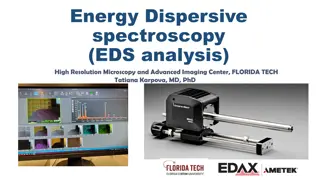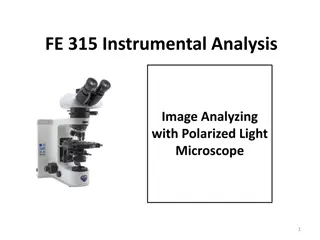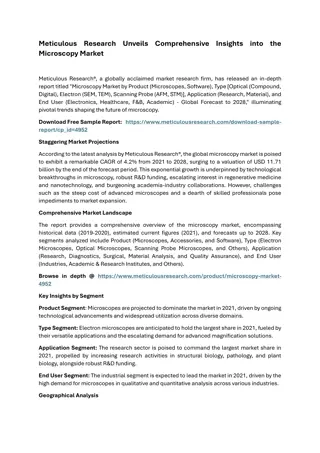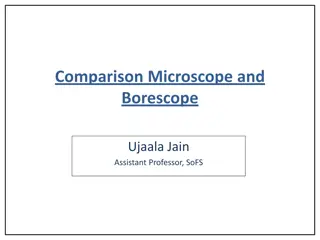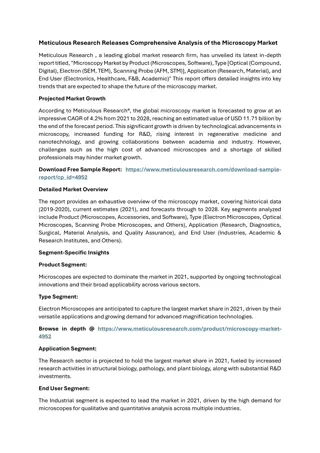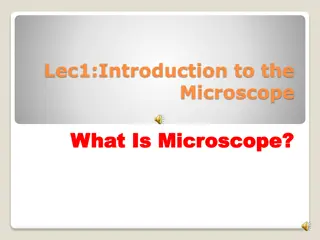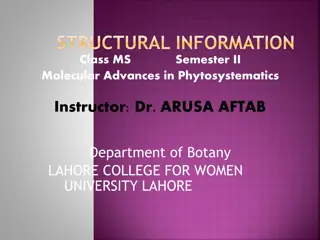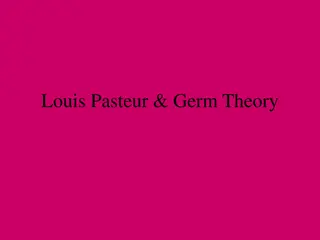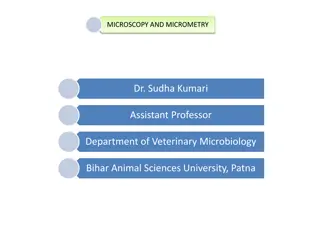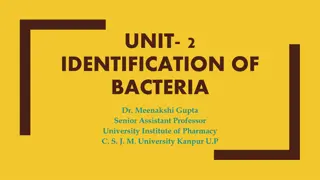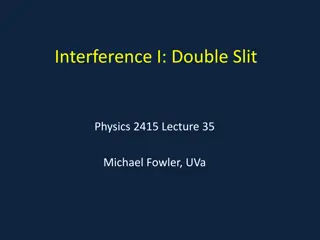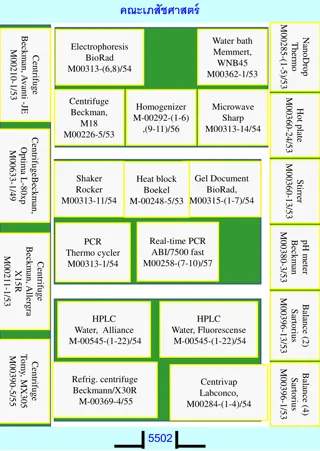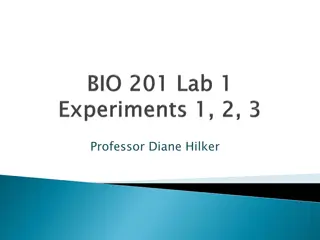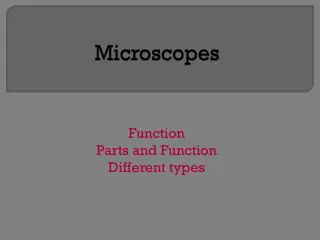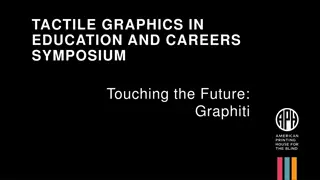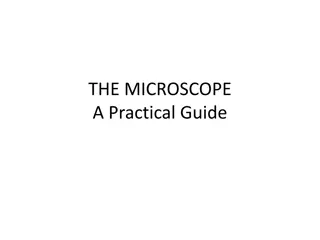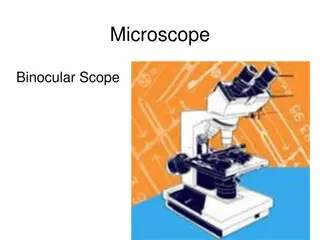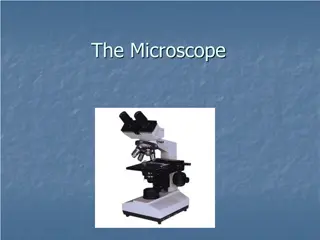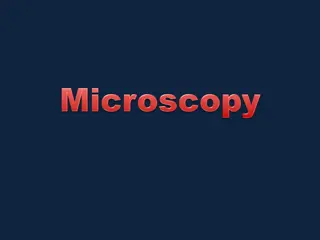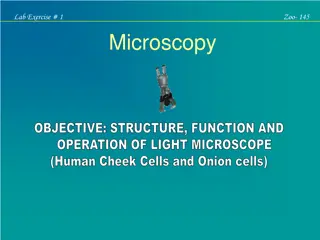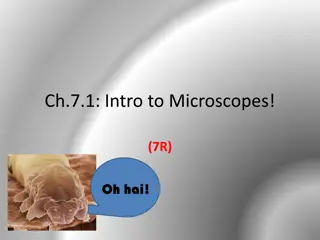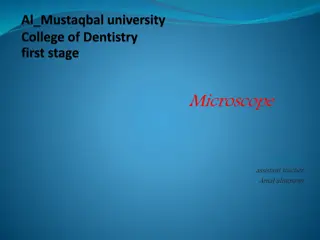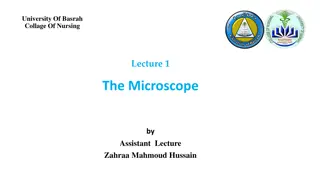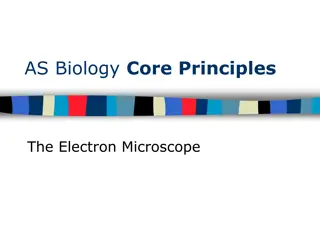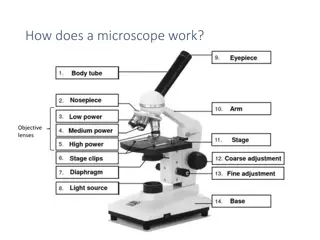Understanding Energy Dispersive Spectroscopy (EDS) in Microscopy
Energy Dispersive Spectroscopy (EDS) is a powerful X-ray microanalytical technique utilized in scanning and transmission electron microscopes to determine the chemical composition of samples. By analyzing the X-ray signals generated from interactions with the sample's atoms, EDS enables qualitative
8 views • 30 slides
Understanding Polarized Light Microscopy in Instrumental Analysis
Microscopes are essential tools for examining small details in samples. Polarized Light Microscopes (PLM) use polarized light to enhance image quality and study birefringent materials. This article covers the basics of microscopes, the principles of PLM, the differences between PLM and LM, and the a
2 views • 16 slides
Advanced Techniques in Materials Science: Transmission Electron Microscopy
Explore the advanced techniques used in materials science, focusing on Transmission Electron Microscopy (TEM). Learn about the challenges with optical microscopes, the principles of TEM imaging, and the application of scattering theory in electron microscopy. Discover how TEM offers higher resolutio
3 views • 19 slides
Medical Equipment Fundraising Campaign
Help support our mission to provide essential medical equipment such as baby incubators, gynecological examination tables, ultrasound machines, infant warmers, IV poles, microscopes, and anesthesia machines. Your contributions will make a significant impact on improving healthcare facilities in unde
1 views • 13 slides
Meticulous Research Unveils Comprehensive Insights into the Microscopy Market
Microscopy Market by Product (Microscopes, Software), Type [Optical (Compound, Digital), Electron (SEM, TEM), Scanning Probe (AFM, STM)], Application (Research, Material), and End User (Electronics, Healthcare, F&B, Academic) - Forecast to 2028
7 views • 2 slides
Comparison Microscope and Borescope
Instruments like Stereomicroscope, Comparison Microscope, and Borescope are used for individual examination, side-by-side comparison, superimposition, and analysis of barrels in forensic investigations. Comparison microscopes are used for examining fired cartridge cases but have limitations such as
1 views • 8 slides
Meticulous Research Releases Comprehensive Analysis of the Microscopy Market
Microscopy Market Size, Share, Forecast, & Trends Analysis by Product (Microscopes (Optical [Compound, Stereo, Digital] Electron [SEM, TEM] Scanning Probe [AFM, STM]), Software) Application (R&D, Material Analysis) End User
0 views • 2 slides
Understanding Mixtures and Separation Techniques
Explore the concepts of mixtures and separation, from the definition of dominant and recessive alleles to the advantages of electron microscopes. Learn about identifying pure substances, differences between pure and impure substances, and techniques like filtration and crystallization for separation
1 views • 19 slides
An Overview of Cell Biology: From Cytology to Modern Studies
Cell biology, also known as cytology, explores cells from various perspectives including physiological, developmental, and evolutionary aspects. Modern Cell Biology delves into the mechanisms of metabolism, heredity, and evolution at the molecular level, involving proteins, RNAs, and DNA. The compar
0 views • 13 slides
Evolution of Microscopes: From Reading Stones to Phase-Contrast Microscopy
The history of microscopes dates back to the 11th century with the invention of the reading stone, leading to the creation of wearable eyeglasses in the 13th century. The first microscope was developed in the late 16th century by Zacharias Jansen, paving the way for the compound microscope and the t
0 views • 17 slides
Understanding Structural Information in Phytosystematics: A Molecular Perspective
Exploring the significance of taxonomic characters in molecular advances of phytosystematics, this class delves into the role of structural attributes in determining relationships between taxa. From considering gross morphological characters to analyzing morphological characters under microscopes, t
0 views • 24 slides
Journey to Understanding Disease Causes
Louis Pasteur's advancements in microbiology, from the discovery of microorganisms by Leeuwenhoek to the establishment of germ theory, revolutionized our understanding of disease causation. Through improved microscopes and experiments, Pasteur's work linked microorganisms to disease, setting the sta
0 views • 10 slides
Basic Concepts of Microscopy for Materials Study
Microscopy plays a crucial role in examining the structural elements and defects influencing material properties. This involves studying microscopic features like grain size and shape using optical, electron, and scanning probe microscopes. Microstructural examinations help understand property-struc
1 views • 12 slides
Understanding Microscopy and Micrometry in Veterinary Microbiology
Microscopy and micrometry play a crucial role in observing small organisms like microorganisms, making them visible for study. This article delves into the history, definition, types of microscopes, variables used in microscopy, and the significance of these tools in veterinary microbiology.
1 views • 15 slides
Bacteria Identification Techniques: Staining and Microscopy Overview
Staining techniques in microbiology play a crucial role in visualizing bacteria under microscopes. This content covers the importance of staining, types of dyes, wet and dry mounts, hanging drop technique, and different types of staining methods employed in identifying bacteria. Explore the basics o
0 views • 39 slides
Understanding Optics and Magnification in Physics
Today's lecture covers a brief review of optical instruments, Huygens principle, refraction phenomena, and Young's double slit experiment. The session delves into magnifying glasses, magnification power definition, astronomical telescopes, and simple and compound microscopes. Key concepts include th
7 views • 20 slides
Laboratory Equipment Inventory and Facilities Overview
Inventory of laboratory equipment including water baths, centrifuges, microscopes, freezers, incubators, and more. Facilities overview featuring imaging microscopes, fume hoods, autoclaves, and other essential lab tools.
0 views • 5 slides
Understanding the Compound Light Microscope and Its Applications
Explore the fundamental concepts of microscopy through Professor Diane Hilker's detailed lectures on the use and care of the compound light microscope. Dive into topics like magnification, resolution, and the practical application of microscopes in scientific research. Enhance your understanding of
0 views • 17 slides
Introduction to Histology and Cell Structure
Histology is the microscopic study of normal tissues utilizing light and electron microscopes. This field explores the composition and function of cells, focusing on the nucleus, cytoplasm, organelles, and inclusions. Thin tissue sections stained with Haematoxylin and Eosin reveal distinct cellular
0 views • 23 slides
Understanding Histology and Cell Structure Fundamentals
Delve into the intriguing world of histology and cell structure, exploring the composition of cells, the functions of various components like the nucleus and cytoplasm, and the significance of organelles. Discover how histology is studied, the types of microscopes used, and the vital role of the cel
0 views • 24 slides
Understanding Microscope Functionality and Different Types
Learn about the essential parts and functions of microscopes, including magnification, resolution, and different types such as bright-field, dark-field, phase-contrast, dissecting, and inverted microscopes. Discover how parfocal microscopes maintain focus and the roles of ocular lenses, nose pieces,
0 views • 28 slides
Tactile Graphics in Education and Careers Symposium
This symposium explores the innovative use of tactile graphics in education and careers, showcasing advanced tools like the Graphiti system. The featured physical unit offers a versatile layout with various connectivity options, coupled with enhanced functionality for viewing and editing graphics. P
0 views • 10 slides
Understanding Cell Structure and Microscopy
Explore the world of cell biology and microscopy through a quiz covering topics such as cell structure, iodine use in the laboratory, magnification in microscopes, and more. Test your knowledge and learn about crucial aspects of cellular biology in an interactive format.
0 views • 50 slides
An Overview of Microscopes and Their Applications
Microscopes play a crucial role in clinical practice, with light microscopes being commonly used for viewing specimens. Different types of light microscopy, including brightfield and darkfield, offer unique ways to visualize organisms. Advanced techniques like phase-contrast and fluorescence microsc
0 views • 22 slides
Exploring Microscopes: Parts, Functions, and Advancements
Delve into the world of microscopes by understanding their parts, usage, and the evolution of technology. Discover the intricacies of plant and animal cells, the limitations of light microscopes, total magnification calculation, differences between light and electron microscopes, and the concept of
0 views • 10 slides
Exploring Microscopes: Insights into Binocular and Monocular Views
Delve into the world of microscopes with detailed images of binocular and monocular scopes, showcasing adjustable lenses and color-coded objective lenses for precise viewing. Learn about the parts like rotating nose piece, mechanical stage, and coarse/fine adjustment mechanisms. Discover essential t
0 views • 10 slides
Understanding the Microscope: Parts, Functions, and Usage
Explore the fascinating world of microscopes by learning about the different parts, their functions, and how to use them effectively. Discover the magnification principles, focusing techniques, and differences between light and electron microscopes. By the end, you'll be equipped with the knowledge
0 views • 16 slides
Understanding Microscopes: Light vs. Electron Microscopes
Learn about the differences between light microscopes (LM) and electron microscopes (EM), including their magnification power, resolving power, and key parts. Explore the types of electron microscopes such as Transmission Electron Microscope (TEM) and Scanning Electron Microscope (SEM) for advanced
0 views • 8 slides
The Fascinating World of Microscopes: From Ancient Origins to Modern Mechanisms
Delve into the intriguing history of microscopes, from ancient experimentation to the innovative creations of individuals like Zacharias Janssen, Anthony van Leeuwenhoek, and Robert Hooke. Explore how these optical instruments work, utilizing convex lenses to bend and focus light for magnification.
0 views • 27 slides
Understanding Microscopes: A Comprehensive Guide
Microscopes are essential instruments used to see objects that are too small for the naked eye. They work by magnifying and resolving objects, with features like working distance and parfocality. Different types, such as bright field and dark field microscopes, serve various purposes. Components lik
1 views • 26 slides
Introduction to Light Microscopy: Structure, Function, and Operation
Light microscopy is a vital instrument used for studying small organisms or particles invisible to the naked eye. This lab exercise delves into the history, types, components, and operation of light microscopes, focusing on human cheek cells and onion cells. Explore the magnification and resolution
0 views • 17 slides
Exploring Microscopes: From History to Modern Advances
Delve into the fascinating world of microscopes, from the basic designs of the past to the sophisticated electron microscopes of today. Discover the significant figures who shaped microscopy, such as the Janssen brothers, Robert Hooke, and Anton van Leeuwenhoek. Learn about the essential parts and f
0 views • 22 slides
Understanding the Components of a Light Microscope
A light microscope is an essential instrument for examining small objects. It utilizes visible light and magnifying lenses to reveal details not visible to the naked eye. Learn about the different types of light microscopes and their components, such as the ocular lens, nosepiece, objective lenses,
0 views • 11 slides
Understanding the Microscope in Nursing Education
Explore the significance of the microscope in the field of nursing education through this lecture by Assistant Lecture Zahraa Mahmoud Hussain at the University of Basrah College of Nursing. Learn about the types of microscopes, their common uses in medical and life sciences, and the essential parts
0 views • 7 slides
Exploring Microscopy: Light vs Electron Microscopes
Microscopy has evolved significantly since Robert Hooke's discovery of cells in cork in 1665. This article delves into the fundamental principles of light and electron microscopes, discussing resolving power, magnification capabilities, and the differences between these two essential tools in biolog
0 views • 17 slides
Understanding Interfacial Defects and Microscopy in Materials Science
Interfacial defects are boundaries separating regions with different crystal structures, like grain boundaries in polycrystalline materials. Microscopic examination distinguishes between macroscopic and microscopic dimensions, analyzed through optical and electron microscopy methods. Electron micros
0 views • 9 slides
Understanding Scanning Electron Microscopes (SEM) and Electron Sources
Scanning Electron Microscopes (SEMs) utilize focused electron beams to produce high-resolution images by interacting with a sample's electrons. The electron source, such as the electron gun, plays a crucial role in forming fine electron beams for imaging purposes. Different types of electron sources
0 views • 12 slides
Effective Support Strategies for Virtual Microscope Use in Education
Evaluation and analysis of support strategies for utilizing virtual microscopes in education, focusing on student impressions, satisfaction, learning outcomes, and usability issues. Existing studies highlight technical specifications, students' preferences for physical versus virtual microscopes, an
0 views • 17 slides
Exploring the World of Microscopes and Cells
Delve into the fascinating world of microscopes and cells with details on how microscopes work, the functions of key microscope parts, the structure and function of cells, levels of organization in living organisms, and the concept of specialized cells. Discover the importance of objective lenses, f
0 views • 26 slides
Exploring Living Cells with Light Microscopes in Classrooms
Light microscopes are commonly used in classrooms to examine living cells, even though they do not provide high magnification levels. Magnification, representing the ratio between an object's image and real size, is limited to about 1,000 times with light microscopes.
0 views • 71 slides
